Russian Banana Fingerling Potatoes Date Back To The 18th Century
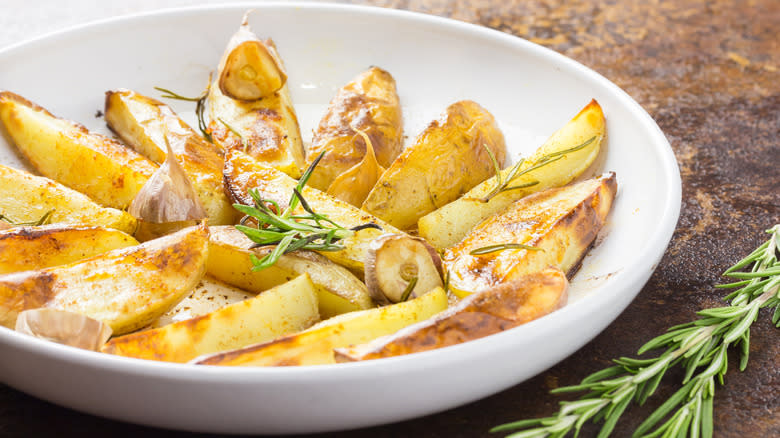
For potato lovers, there's more to life than Russets and Yukon Gold. There are over 4000 varieties of potato (Solanum tuberosum), according to the International Potato Center, and interesting varieties are increasingly available to shoppers, chefs, and especially gardeners. You'll find them in all shapes and sizes ("potato-shaped" is pretty vague when you think about it) and in shades ranging from snowy white to golden yellows, rosy pinks and reds, and deep purples.
One of those alternative varieties is the Russian Banana fingerling potato, which is available across much of the country through specialty retailers and farmer's markets. It's also the fingerling potato you'll see most in restaurants.
I'm an avid gardener, and I've grown these in my own garden and cooked with them at home. As a former chef and restaurateur, I've also prepared them professionally. With that in mind, here's what you need to know about Russian Banana fingerlings and how to incorporate them into your cooking.
Read more: 23 Types Of Potatoes And When To Use Them
What Are Russian Banana Fingerling Potatoes?
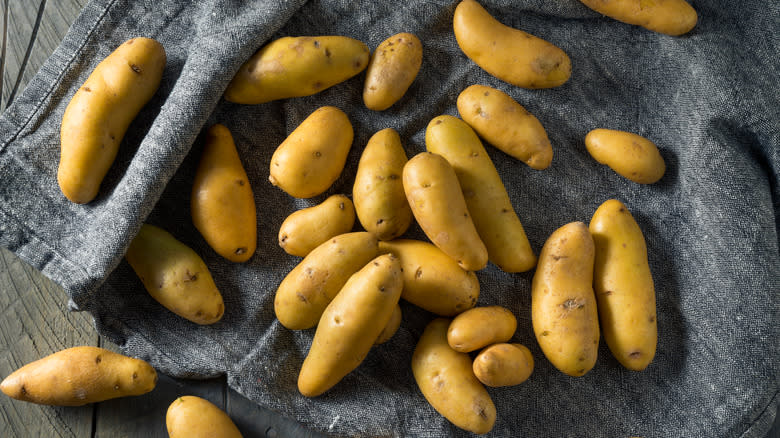
Fingerling potatoes have a distinctive shape, and Russian Bananas are no exception. Instead of the chunky oblong of a big russet or the relatively round shape of a Yukon Gold, fingerlings have a longer, narrower shape. They are indeed a bit finger-like, though you won't see fingers that round on any healthy human.
Russian Banana fingerlings, specifically, have a gently curved shape and pale golden color, which is where the "banana" part of their name comes from. The "Russian" part is because the variety is thought to originate in the 18th century on the Baltic coast, which was then part of the Russian Empire. Sailors spread it from there across Europe's busy Baltic trading routes, and the Canadian government credits Russian fur traders for bringing it to the west coast of North America.
The Russian Banana fingerling is a relatively small potato, typically 2 to 3 inches in length, with a delicately thin skin. Unlike some potatoes, which are one color on the outside and another on the inside, the Russian Banana's pale golden color goes all the way through its flesh.
How Are Russian Banana Potatoes Different From Other Potatoes?

If you look at any good list of the types of potatoes and how they're used, you'll quickly see that they break down into a few broad categories. Some are large and oblong (like Kennebecs); others are mid-sized and typically rounder (Yukon Gold, Red Bliss); and some are smaller "specialty potatoes" (fingerlings and new potatoes). A second major distinction is between waxy potatoes and mealy or starchy potatoes. "Starchy" potatoes, such as russets, are the kind that cook up dry and fluffy. "Waxy" potatoes are the kind that cook up firm and moist. In truth, they're similar in total starch content, but it's the type of starch that matters.
Plant foods contain two main starches: amylose and amylopectin. As Richmond University's Chemistry of Cooking course explains, amylose expands and "puffs" during cooking, while amylopectin remains compact and dense. Potatoes high in amylose, then, are fluffy and starchy, while waxy potatoes have a lower percentage of amylose but more amylopectin.
As a fingerling, Russian Bananas obviously fall into the smaller "specialty potato" category, and they're waxy potatoes. That distinction is what decides which type of potato to use in a given recipe, something we'll circle back to shortly.
Are Russian Banana Fingerlings Like New Potatoes?

You may have noticed that recipes written for new potatoes often suggest fingerlings as an alternative, and the opposite is true as well. Does this mean that fingerlings such as the Russian Banana are like new potatoes? Well, yes and no.
New potatoes are exactly what the name says: A potato that's harvested while it's still young and immature. They're moist and creamy, just like waxy potatoes (they're sometimes sold as "creamers"). A key difference is that Russian Banana fingerlings and other waxy potatoes will stay small and waxy even as they mature. This is more of a consideration for gardeners than for shoppers: you can use your new potatoes in recipes that need waxy potatoes, like a classic potato salad, but after just a few more weeks, they'll be too big to substitute for fingerlings.
Physically, Russian Bananas can also be somewhat larger than new potatoes. New potatoes are typically small and round, at diameters of (usually) 1 ½ inches or less. Banana fingerlings can have a similar diameter but be 3 inches long and occasionally more. You can still use them in recipes written for new potatoes, but in situations where the new potato is used whole, you might need to cut up your fingerling into smaller pieces.
What Do Russian Bananas Taste Like?
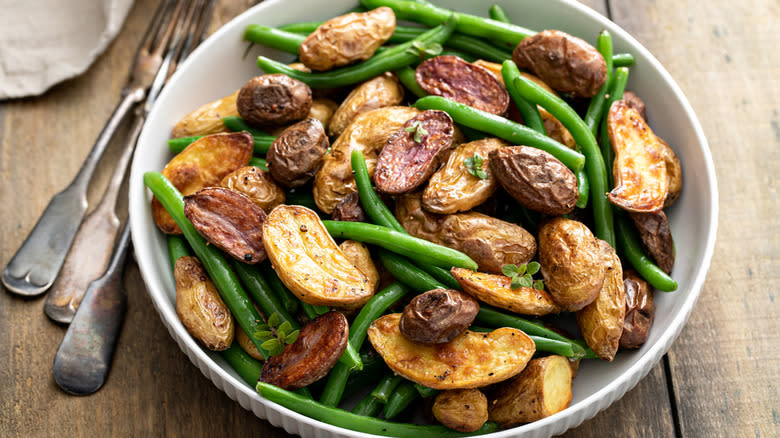
The big question, of course, is how do Russian Banana potatoes taste? It's not something you ask yourself when you're out buying ordinary supermarket potatoes because potatoes are fairly bland and typically fade into the background of your meal. That's not necessarily the case when you splash out for a premium potato because you'll want them to stand out more as a component of the final dish.
That's one of the reasons why professional chefs widely use the Russian Banana. We find they have a relatively full flavor, pleasantly nutty, and with a distinct buttery undertone that most potatoes don't — so to speak — bring to the table. They'll stand on their own, with minimal flavoring, but they'll also provide a robust complement to any spices, herbs, or sauces your recipe calls for.
Their texture is smooth and creamy when cooked, and here again, the adjective "buttery" will spring to mind. They're very different from the light, fluffy texture of a russet potato or even the relatively familiar Yukon Gold, which, like other "all-purpose" potatoes, is halfway between a waxy and a mealy potato.
Are Russian Banana Potatoes Nutritious?

Potatoes, in general, have gotten a bad rap after a decade or two of well-hyped low-carb diets, but you certainly can't call them "empty calories." In fact, Popular Science reported the story of a man who lived on potatoes for a year, like Mark Wahlberg's character in "The Martian," just to show that he could. You'd eventually need some supplemental protein and a few more vitamins and minerals, but they're surprisingly nutritious overall.
Because they're a niche product, it's hard to find information about fingerling potatoes in general or Russian Banana potatoes specifically, but Tufts University cites fingerlings as a useful source of vitamins C and B6 (pyridoxine) in particular. Also, Russian Bananas are almost always served with their skins on, which means they contain more healthy fiber. Data from the USDA's FoodDataCentral shows that a baked potato with skin has roughly 50% more fiber than a baked potato without skin.
It's also interesting to note that a 2005 paper in the British Journal of Nutrition found that waxy potatoes have a lower glycemic index than mealy potatoes. That's good news if you're a potato lover, but you're watching your blood sugars.
How And Where To Buy Russian Banana Potatoes
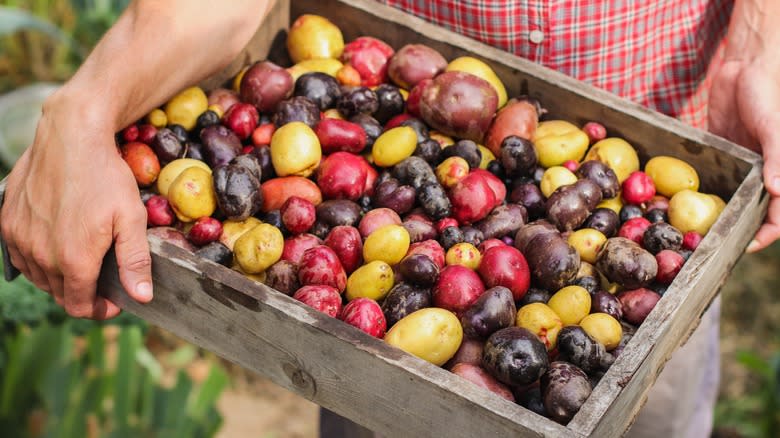
Ordinary potatoes can be found anywhere, from your supermarket to convenience stores and gas stations. It's a little more challenging if you want to find fingerling potatoes, especially if you want Russian Bananas or other specific individual fingerling (as opposed to the mixed bags of fingerlings sold at some stores).
Generally speaking, your best bets will be in upscale or specialty produce markets if you live in a community large enough to support those. It's also worth checking any farmer's markets or farm-gate sellers in your area. These small-scale entrepreneurs are very responsive to customer demand and always look for products that can command a premium price. If you ask for it, they'll think long and hard about growing it.
If you've considered signing up for a CSA (Community Supported Agriculture) subscription, all the same points apply to those. Some farms may already be growing Russian Bananas or other fingerling potatoes, and those who aren't would probably be willing to entertain the idea.
Why Do Fingerling Potatoes Cost So Much More Than Regular Potatoes?

One thing that you'll notice, wherever you buy your Russian Banana potatoes — or other fingerlings, for that matter — is that they cost more than regular potatoes. That's good because it gives small growers a reason to cultivate them for you, though it's bad for your grocery budget.
It's not because the plants aren't productive, as such. Writing for the National Gardening Association, gardening legend Charlie Nardozzi reported yields of up to 20 pounds per seed potato for fingerlings, while 8 to 12 pounds is normal for many other varieties. The problem is that because the potatoes are so small and their skins are so delicate, they don't lend themselves well to commercial production and mechanical harvesting.
The cost of seed potatoes is another issue, precisely because fingerlings cost more (a bit of a Catch-22 for growers). To make matters worse, because they're small, you won't get as many viable seeds from each potato. Often, you'll plant the potato whole rather than cutting it into pieces. Finally, there's the question of demand: Fingerling potatoes are a niche product, so the "economies of scale" that big producers rely on don't come into the picture.
Growing Your Own Russian Banana Potatoes

Potatoes are a reliable crop that works well in just about every corner of the continent. According to urban gardening hub CC Grow, short-season varieties can grow as far north as Zone 2, while warm-climate gardeners in USDA Zones 8 and up can plant them in autumn for a spring harvest.
Russian Banana potatoes need 90 - 105 days to mature. As with any potato, they prefer well-drained soil with lots of organic content and don't like clay soils. Plant them about a foot apart in early spring, roughly two weeks before the last frost. As they grow, hill them up regularly (pile dirt around them) to maximize production.
Potatoes are part of the nightshade family, like tomatoes, and like tomatoes, they come in indeterminate and determinate varieties. Russian Bananas are a determinate variety, meaning the potatoes will mature all at once, and then the plant stops producing. You can start harvesting them as new potatoes as soon as they're big enough and dig the rest in autumn once they've stopped growing. According to Cornell University, they're resistant to scab and somewhat resistant to late blight.
How To Store Russian Banana Potatoes
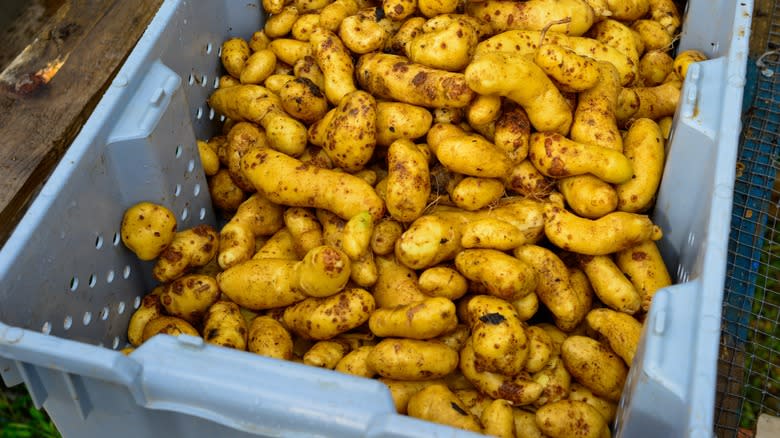
New potatoes are perishable and require refrigeration, but mature Russian Banana fingerlings have the same storage requirements as regular potatoes. For gardeners, storage starts with curing the newly-harvested tubers. That means keeping them in a cool, humid place for a couple of weeks so their skins can thicken and any damage from harvesting can scab over. After those two weeks, you can store them normally, like store-bought fingerlings.
Ideal storage conditions are tuned to the potatoes' biology. They're genetically programmed to sprout when the weather warms up, so keep them cool — as low as 40 to 45 degrees Fahrenheit, according to Iowa State — to extend their storage life. Light also promotes sprouting, so keep them in a dark spot. Humidity helps keep them from shriveling, so keep the humidity as high as possible. Finally, that humidity can cause mold and spoilage, so they also need decent air circulation.
An old-fashioned root cellar meets those conditions nicely, but most of us don't have one of those. An unheated corner of your basement works well. Failing that, do the best you can. Look for a cool, dark, well-ventilated spot (we've used a drafty closet on a north-facing wall), and keep the potatoes in a paper bag or perforated plastic bag. Check them periodically, remove any that are spoiling or showing mold, and cook or discard any that are sprouting (you'll need to remove the sprouts first, of course). According to Oregon State University, Russian Bananas are a good "keeper."
Do I Need To Peel Russian Banana Potatoes?

The whole idea of peeling potatoes is divisive. They carry a lot of the potato's nutrition and fiber, but they can also be unsightly, and some people just don't like them. With Russian Banana fingerlings, it's a different story. Because their skins are so thin and delicate, peeling them isn't necessary. In fact, because the potatoes are so small and slender, it's not an especially practical option. If you peeled them, you'd have very little potato left! Given the cost of fingerling potatoes, that's a significant penalty.
Accordingly, most recipes for fingerling potatoes assume you'll leave the skin on. They're part of what gives your potato dishes that Insta-worthy look. All these potatoes usually need for preparation is a good wash — when washing waxy potatoes, especially thin-skinned ones, use your hands rather than a brush to protect their delicate skins — and you should remove any sprouts or damaged areas with the tip of a paring knife. After that, they're ready to use in your recipe of choice. Those who are adamant about not eating potato skins can peel them easily after they're steamed, boiled, or parboiled.
What Kind Of Dishes Are Russian Banana Fingerlings Best In?
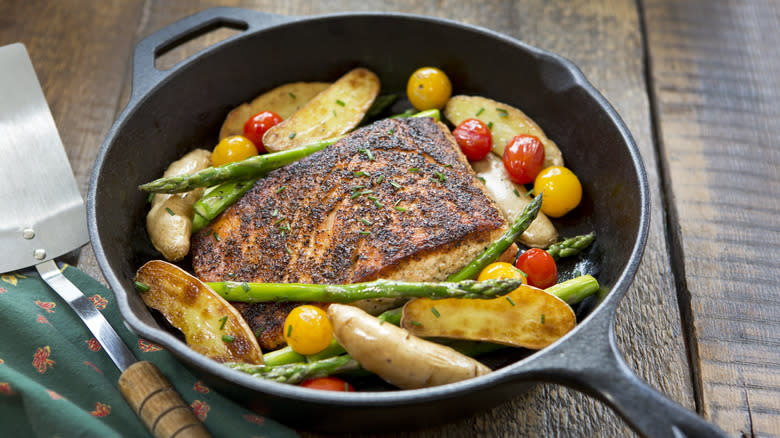
When we talk about the differences between waxy and mealy potatoes, they ultimately come down to choosing the right potato for the job. This is where the rubber hits the road because both mealy and waxy potatoes have their strengths. You'd want a mealy potato for mashing, for example, or for a perfectly light and fluffy baked potato.
Waxy potatoes like the Russian Banana stand up to wet cooking methods and will boil without disintegrating in the water, which makes them great in soups and stews. Their texture makes for a creamier potato salad, and they'll also hold together better in your favorite potato-based casseroles. One of the signature uses for fingerling potatoes is roasting, with your favorite herbs or spices. It's a high-impact way to take advantage of their appealingly small size and appearance.
Although American-style mashed potatoes are usually made with russets or other mealy potatoes, fingerling potatoes are the best for pomme puree. That's the French version of mashed potatoes, but they're a richer and smoother side dish made with copious quantities of cream and butter. The traditional choice for that dish is a French fingerling called La Ratte (which actually means "the rat" for its shape), but Russian Bananas are fine as well.
Recipe Ideas For Russian Banana Fingerlings

If you've read this far, hopefully, you're sold on trying some Russian Banana fingerlings for yourself. We have lots of recipes for you to try, and here are a few that show off Russian Bananas' versatility.
To give yourself a benchmark for their flavor and texture, you might start out with our deceptively simple parsley potatoes recipe. Garlic butter complements the fingerlings' flavor without overwhelming it, while the parsley adds a clean vegetal note (and helps your breath). Another dish showcasing the fingerlings' versatility is our creamy dill potato salad recipe, making a fine side for backyard summer barbecues.
We've mentioned that Russian Bananas are excellent when roasted, and our extra-crispy fingerling potatoes show why. Par-boiling the potatoes first is the crucial step, and it makes some of the best-roasted potatoes you'll ever eat. Finally, for a recipe with bolder flavors, try these fingerlings in our Gamja Jorim (Korean roast potatoes) recipe. They're the exact opposite because they're roasted or fried first and then braised in flavorful liquid that reduces to form a tasty glaze.
Best Substitutes For Russian Banana Fingerlings

So what should you do if you develop a taste for Russian Banana fingerlings, plan meals around them, and then abruptly find that they aren't available when you need them? It's always a risk when you're working with niche products like a fingerling potato: stores stop carrying them, local growers run through their year's supply, and so on.
In those cases, your most direct substitute is another fingerling potato. You may see a variety of others in your local markets, including French Fingerling (aka Roseval), La Ratte, Red Thumb, Ozette (aka Haida), and a number of deep-blue cultivars. Go with whichever fingerling potato you can find. Some stores sell them in a mixed bag, with white, golden, red, or blue varieties included. The combination makes for a striking impression on your plate, and the red-white-blue combo is natural for your July 4th block party.
If you can't find fingerling potatoes at all, your next-best substitute is new potatoes. They're similarly small, waxy in texture, and visually appealing, so you can use them in most recipes that would otherwise feature fingerlings. Your last-ditch substitute, if nothing else turns up, is any other waxy potato or even a yellow all-purpose potato like a Bintje or Yukon Gold. You may find enough small ones in your bag to use like new potatoes; otherwise, you can cut them to size as needed.
Read the original article on Tasting Table.

